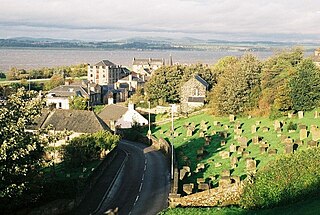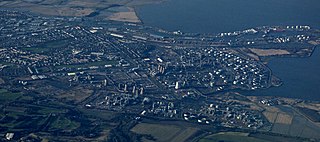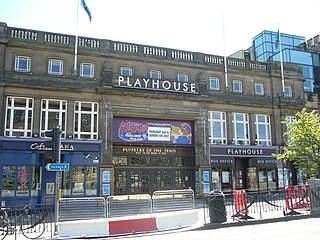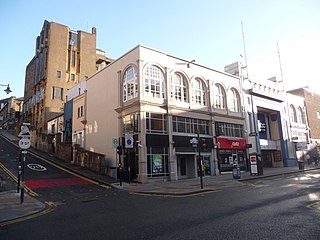
Borrowstounness is a town and former burgh and seaport on the south bank of the Firth of Forth in the Central Lowlands of Scotland. Historically part of the county of West Lothian, it is a place within the Falkirk council area, 17 miles northwest of Edinburgh and 6+3⁄4 miles east of Falkirk. At the 2011 United Kingdom census, the population of the Bo'ness locality was 15,100.

Grangemouth is a town in the Falkirk council area, Scotland. Historically part of the county of Stirlingshire, the town lies in the Forth Valley, on the banks of the Firth of Forth, 3 miles (4.8 km) east of Falkirk, 5 miles (8.0 km) west of Bo'ness and 13 miles (20.9 km) south-east of Stirling. Grangemouth had a resident population of 17,906 according to the 2001 Census. Preliminary figures from the 2011 census reported the number as 17,373.

The Falkirk Stadium is a football stadium in Falkirk, central Scotland, which is the home ground of Scottish League One club Falkirk and Lowland Football League club East Stirlingshire. The stadium has a capacity of 7,937 and currently consists of three fully completed stands.

Bedlam Theatre is a theatre in the Old Town of Edinburgh, Scotland. The building was completed in 1848 for the New North Free Church. After closing as a church in 1941, the building served as a chaplaincy centre and then a store for the University of Edinburgh before reopening in 1980 as the student-run theatre of Edinburgh University Theatre Company (EUTC).

The Cameo is an Edinburgh cinema which started life as the King's Cinema on 8 January 1914 and is one of the oldest cinemas in Scotland still in use. Since becoming the Cameo in 1949, it has had a tradition of showing art house films. From 1949 onward it has been an important venue for the Edinburgh International Film Festival. It is at Tollcross, and since 1992 has been a three-screen cinema. The Cameo was an independent cinema until 2012, when it was bought by the Picturehouse chain, owned by Cineworld.

The Tron Kirk is a former principal parish church in Edinburgh, Scotland. It is a well-known landmark on the Royal Mile. It was built in the 17th century and closed as a church in 1952. Having stood empty for over fifty years, it was used as a tourist information centre for several years in the mid 2000's and, more recently, was the site of the Edinburgh World Heritage Exhibition and John Kay’s book and gift shop.

Edinburgh Playhouse is a theatre in Edinburgh, Scotland. With 3,059 seats it is the second largest theatre in the United Kingdom after the Hammersmith Apollo. The theatre is owned by Ambassador Theatre Group.

Bo'ness railway station is a heritage railway station in Bo'ness, Falkirk, Scotland. This station is not the original Bo'ness railway station, which was located roughly a quarter mile west on Seaview Place. The site of the original station is now a car park.
Bo'ness Hill Climb is a hillclimbing course on the Kinneil Estate (site of the historic Kinneil House near Bo'ness, Scotland. It is sometimes referred to as Kinneil Hill Climb. Opening in 1932, it was Scotland's first purpose-built motorsport venue. In 1932 and 1933 events were organised, for motorbikes only, by the West Lothian Motor Cycle Club. The first meeting open to both cars and bikes was organised jointly by WLMCC, Scottish Sporting Car Club and Bo'ness Town Council. There were plans to build a racing circuit on the same land, effectively turning Kinneil into a motorsport complex, but they never came to anything.

TheBritannia Music Hall in Trongate, Glasgow, Scotland is one of the oldest remaining music halls in Britain. It is located above an amusement arcade, at 113-117 Trongate.

Brighton Hippodrome is an entertainment venue in the ancient centre of Brighton, part of the English city of Brighton and Hove. It has been empty and out of use since 2007, when its use as a bingo hall ceased.

The Paramount Theater is an historic theater located at 1676-1708 Main Street in Springfield, Massachusetts. Built in 1926 out of part of the grand Massasoit House hotel at a cost of over $1 million, the Paramount Theater was the most ornate picture palace in Western Massachusetts. As of 2011, The Paramount is in the midst of a $1.725 million renovation to once again become a theater after decades as a disco and concert hall,, when it was the center of Springfield's club scene. In 2018 the building's owners, the New England Farm Workers Council, announced plans to redevelop it in tandem with a new adjacent hotel building. In a push to renovate the Paramount along with Holyoke's Victory Theater, in October 2018, the administration of Massachusetts Governor Charlie Baker announced a $2.5 million grant to assist the project, on top of a $4 million federal loan guarantee. Pending finalizing funding for the combined restoration and new hotel, no construction timeline has been presented as of 2022.
Matthew Steele was a Scottish architect, who worked principally in his hometown of Bo'ness and the surrounding area. He was an architectural designer in the Arts and Crafts and Art Deco design movements and designed The Hippodrome Cinema, thought to be the oldest such building surviving in Scotland. He died in Bo'ness from pneumonia in 1937.

The O2 ABC was a nightclub and music venue on Sauchiehall Street, in the centre of Glasgow, the largest city in Scotland. The building was constructed in 1875, renovated many times in its lifetime and also largely rebuilt in the 1920s. The building has been used for numerous functions before being finally converted to its current purpose between 2002 and 2005. In 2009, the Academy Music Group took a majority stake in the venue, rebranding it the O2 ABC. The venue is protected as a category C(S) listed building. In March 2009; the Academy Music Group became the major stockholder of the O2 ABC.

The Avon Viaduct carries the railway over the River Avon at Linlithgow, West Lothian, Scotland.

Grangemouth Town Hall is a municipal structure in Bo'ness Road, Grangemouth, Scotland. The structure was the meeting place of Grangemouth Burgh Council and remains the main events venue in the area.

Bo'ness Town Hall is a municipal building in Stewart Avenue, Bo'ness, Scotland. The structure, which was the meeting place of Bo'ness Burgh Council, is a Category B listed building.

















